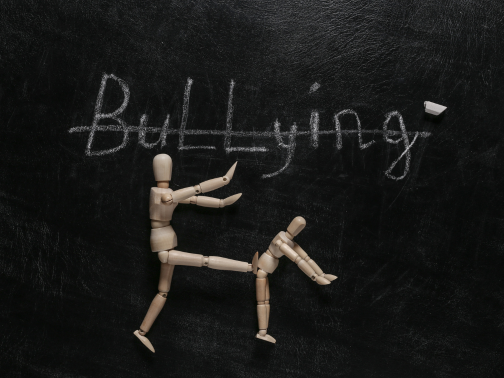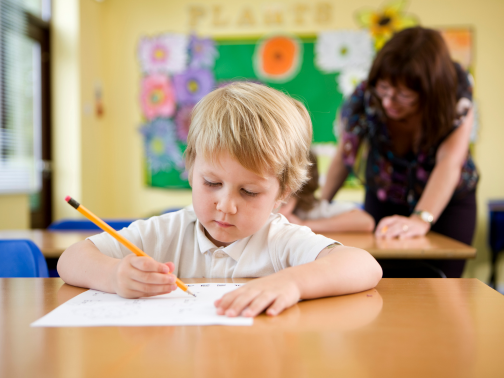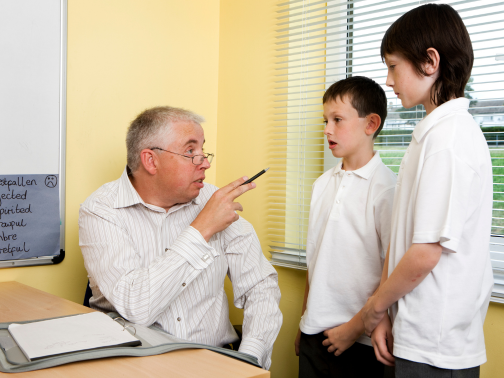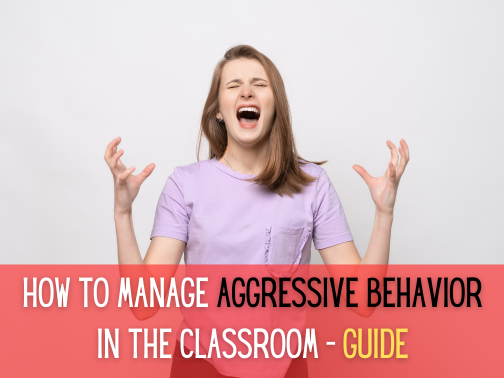Contents
Toggle
Meet David De’ Ath, founder, editor, and writer at Wonderful World English. With his extensive background as an English teacher, David provides valuable insights and practical tips on ESL for students and teachers alike.
Managing aggressive behavior in the classroom is a significant challenge teachers face on a daily basis.
Educators must understand the various factors that can contribute to such behaviors in children and the impact they can have on the learning environment.
A teacher’s ability to effectively address and mitigate these issues is crucial for the student displaying aggression and the entire classroom dynamic.
Teachers must first understand the underlying reasons behind a student’s aggressive behavior. Then, they can develop tailored strategies to prevent these behaviors from recurring. As each student is unique, a flexible approach is key. In certain cases, it’s also important to collaborate with colleagues or parents.
Successful management of aggressive behavior in students involves a variety of strategies centered around communication, classroom management, and relationship-building.
Educators can create a safe and conducive learning atmosphere by employing preventive measures and understanding the root causes of aggression.
When incidents do occur, it’s vital they have intervention techniques at their disposal to de-escalate situations promptly and ensure safety.
Key Takeaways
- Understanding the causes of aggression helps in managing student behaviors effectively.
- Strong educator-student relationships contribute to a positive classroom atmosphere.
- Preventive strategies and timely interventions are key to handling aggressive incidents.
Understanding Aggressive Behavior in Students
Managing aggressive behavior in the classroom requires a clear understanding of what it entails and how various factors contribute to it.
Educators must be able to recognize the different types of aggression and the influences that may lead to such behavior in students.
Identifying Types of Aggression
Aggression in students can manifest in two primary forms: proactive aggression and reactive aggression.
Proactive aggression is deliberate and goal-oriented, where the behavior is used as a means to achieve a desired outcome. On the other hand, reactive aggression is a response to perceived threats or provocation.
It’s important for educators to distinguish between these types of aggression to address them appropriately.
Warning signs of aggressive behaviors can include frequent outbursts, physical acts towards others, or destruction of property.
- Proactive Aggression:
- Goal-oriented
- Planned or premeditated
- Reactive Aggression:
- Emotionally driven
- In response to threats or frustration
Factors Influencing Aggression
Various factors can influence aggression in students, from individual conditions to environmental stressors.
Conditions such as Attention Deficit Hyperactivity Disorder (ADHD) can play a significant role in a student’s inability to regulate emotions, leading to aggressive patterns.
Poverty and associated stressors can also contribute to heightened aggression in students by creating a sense of instability and frustration.
It is essential for educators to consider these factors when addressing aggressive behaviors, as they can impact the effectiveness of any intervention strategy.
- Conditions contributing to aggression:
- Attention Deficit Hyperactivity Disorder (ADHD)
- Other emotional or neurological disorders
- Environmental factors:
- Poverty and socio-economic stress
- Stressful home life or instability
It’s also important to note that aggressive students may often struggle with listening and maintaining focus.
Employing strategies to keep them engaged is crucial.
For more insights and practical advice, refer to the guide and video linked below:
Related Article: How to Engage Difficult Students – Teacher’s Guide

Effective Communication and Relationship Building
Effective communication and relationship building are critical for managing aggressive behavior in the classroom.
They entail verbal exchanges and the non-verbal cues that educators convey to students.
Fostering mutual respect and understanding through these channels can significantly impact the classroom atmosphere.
Fostering Mutual Respect
For educators, establishing mutual respect involves recognizing and valuing students’ perspectives and feelings.
They should ensure clear guidelines are set for behavior and communication in the classroom.
One strategy is to create a classroom agreement that involves input from all students, thereby encouraging ownership and respect for the agreed-upon norms.
Using Body Language and Eye Contact
An educator’s body language and eye contact can convey a multitude of messages, often more powerfully than words alone.
Standing with an open stance, nodding during discussions, and facing students directly show engagement and can create a sense of inclusion.
Maintaining consistent eye contact demonstrates sincerity and interest in what students have to say, establishing a communicative classroom environment founded on mutual respect.
Building Positive Teacher-Student Relationships
Positive teacher-student relationships are the bedrock of effective classroom management and can reduce occurrences of aggressive behavior.
Teachers should strive to know their students individually and show genuine concern for their well-being.
Building this rapport can be achieved through positive reinforcement, personal interest, and consistent, caring interactions, which foster a nurturing learning environment where students feel understood and valued.

Classroom Management and Preventive Strategies
Effective classroom management and preventive strategies are pivotal in mitigating aggressive behavior in students.
They provide a framework for positive student engagement and reduce disruptions.
Establishing a Consistent Routine
A well-established routine is the backbone of sound classroom management. It provides students with a predictable and secure environment, which can significantly reduce anxiety and aggressive responses.
Teachers can establish this consistency by starting each day with a specific welcome procedure or by structuring lessons so that they have a clear beginning, middle, and end.
- Morning Entry: Students follow a set sequence upon entering (e.g., placing belongings in designated spots, starting on a warm-up activity).
- Lesson Structure: Lessons follow a predictable format (introduction, activity, summary).
Implementing Positive Reinforcement
Positive reinforcement can shape student behavior and foster an encouraging classroom atmosphere.
Recognizing and rewarding students for displaying appropriate behavior reinforces their willingness to comply with classroom rules and expectations.
For example, a teacher-focused approach to managing aggression includes creating caring relationships and reinforcing positive behavior.
- Verbal Praise: Acknowledging good behavior with specific commendations.
- Reward Systems: Implementing point systems or tokens for demonstrating positive behavior.
Preemptively Addressing Triggers and Transitions
Identifying potential triggers and smoothly managing transitions are vital strategies for preventing aggressive behavior.
Educators can prevent challenging behavior by being aware of students’ emotional cues and planning transitions carefully to avoid confusion and stress.
- Cue Awareness: Teachers stay attuned to signs of escalating frustration.
- Transition Planning: Clear instructions and signals for changing activities or settings are established.

Intervention Techniques for Aggressive Incidents
Teachers can effectively manage aggressive behaviors in the classroom by employing tailored intervention techniques.
These approaches aim to de-escalate situations, address physical aggression, and assess each incident afterward to promote a safe learning environment.
De-escalating Situations
De-escalating a tense classroom scenario is crucial to prevent the occurrence of aggressive incidents.
Teachers should maintain a calm demeanor and use a low, soothing voice.
They might also find implementing a behavior intervention plan helpful for the student and the class as a whole.
Strategies including redirecting the student’s attention, maintaining safe personal space, and providing clear choices can defuse a situation before it escalates.
Addressing Physical Aggression
When a student resorts to physical violence such as hitting, biting, kicking, or punching a teacher’s immediate response should prioritize everyone’s safety.
Utilizing non-aggressive yet assertive communication to express expectations is key.
Restraint should only be used as a last resort and must be conducted by trained staff to minimize injury risk to all parties involved.
Such incidents often require a review of practical strategies for working with students who display aggression.
These strategies include intervening in a way that respects the student’s dignity and seeks to resolve the issue nonviolently.
Post-Incident Assessments
After an aggressive incident, it’s necessary for educators to conduct post-incident assessments.
This involves evaluating what triggered the behavior and considering the effectiveness of the intervention.
Documentation of the incident, discussions with the student, and planning for future occurrences are integral to this process.
Following an incident, it may be beneficial to understand the phases of the aggression cycle to better prepare for potential future outbursts.
This reflective approach aids in adapting strategies and improving behavior management within the classroom.

Long-Term Solutions and Support
Effective management of aggressive behavior in the classroom requires a multifaceted approach.
It must address immediate concerns while also focusing on strategies that provide long-term solutions and support.
Developing Social and Problem-Solving Skills
Implementing programs that enhance social skills and problem-solving abilities can significantly reduce behavioral issues over time.
These programs, such as those described in 8 Strategies to Manage Challenging Classroom Behaviors, should aim to teach students how to communicate effectively, empathize with others, and resolve conflicts in a non-aggressive manner.
Regular skills training sessions can be conducted to practice these techniques, which are then reinforced through role-playing exercises.
Example Social Skills Curriculum:
- Communication: Practice active listening and expressing feelings
- Empathy: Engage in activities to understand others’ perspectives
- Conflict Resolution: Learn and apply steps to solve disputes peacefully
Collaborating with Parents and Professionals
Strong collaboration with parents and other professionals is crucial when addressing challenging behaviors.
Regular meetings to discuss a student’s progress, concerns, and insights provide a holistic view that can better inform intervention strategies.
Creating a solution-focused plan, with input from all parties, ensures consistency and continuity in both the school environment and at home.
Furthermore, consistent evaluation of a student’s progress allows for timely adjustments to strategies as needed.
Collaboration Framework:
- Monthly meetings with parents
- Inclusion of school psychologists or counselors in planning
- Continuous evaluation of student progress
Referral to Specialized Services
For some students, additional support from specialized services may be necessary.
When behavioral issues persist despite interventions, a formal referral to outside professionals may be appropriate.
This could include educational psychologists, behavioral therapists, or child psychiatrists who have the expertise to conduct more in-depth evaluations and provide targeted therapies.
Referrals should be made with a full understanding of the student’s needs, ensuring the services provided align with the goals set out by the school and family.
Referral Process:
- Identify Persisting Issues: Document specific behaviors and interventions tried.
- Consultation with Experts: Discuss potential referrals with school specialists
- Connect with Services: Formally refer the student and monitor the engagement.

Conclusion
Addressing aggressive behavior is a fundamental aspect of effective classroom management.
Successfully managing such behaviors ensures all students’ safety and fosters a positive learning environment.
Teachers must apply the strategies outlined in this guide to engage appropriately with aggressive students without escalating the situation.
Understanding the underlying causes of aggression is key.
It enables teachers to comprehend the motivations behind a student’s behavior and develop targeted strategies for addressing it.
Collaboration with parents, colleagues, and behavioral experts can significantly enhance the management of aggressive behaviors.
These partnerships provide additional perspectives and support, helping teachers stay motivated and effective in their approach.
Teachers must be skilled at effective communication, lead by example, and offer personalized support to students with behavioral challenges.
We hope this guide has equipped you with valuable tools and insights for managing aggressive behavior in your classroom, contributing to your overall success and fulfillment in your teaching career.
We wish you the best in your endeavors!
If you require support or assistance, do not hesitate to reach out.
Have a wonderful day!
Image Attribution: All images licensed via canva.com





